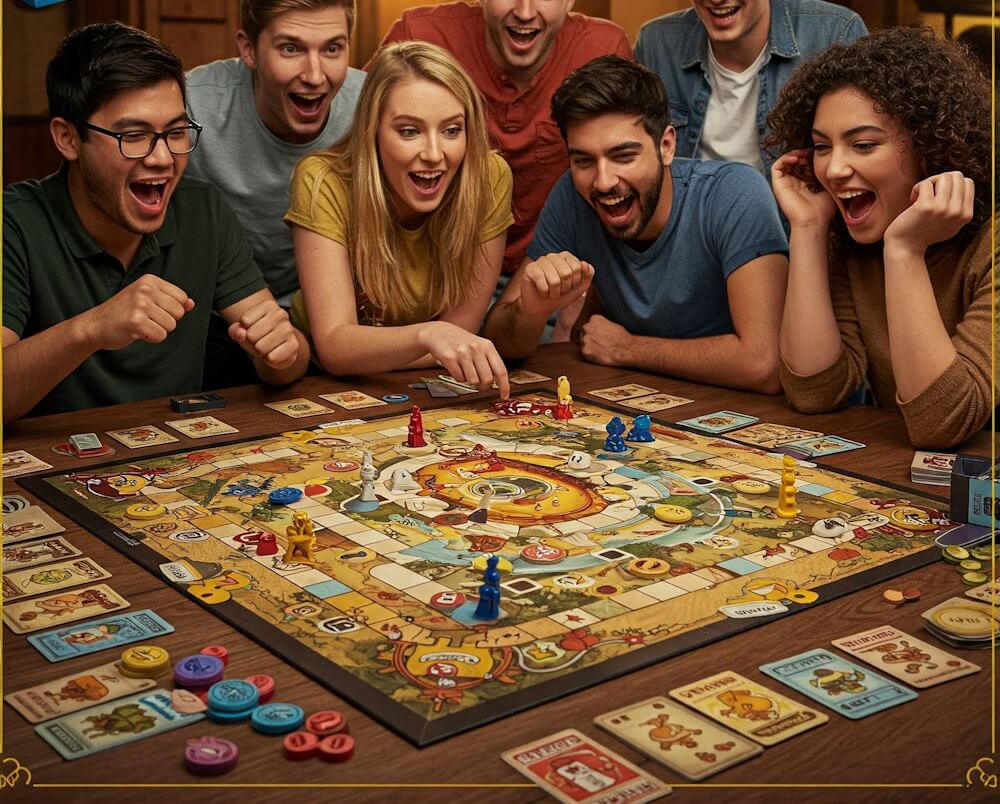Board games have long served as a source of entertainment, but certain titles have developed a reputation for their addictive qualities. The allure of these games often stems from multiple psychological factors that engage players on various levels. One key aspect is the social dimension of board gaming; many games are designed for groups, encouraging interaction and fostering relationships. This social aspect not only enhances the enjoyment but also increases the likelihood of repeated play sessions, as players seek the camaraderie and shared experiences that emerge during gameplay.
Furthermore, the thrill of competition is another significant factor contributing to board game addiction. Many games are structured around competitive elements, where players strive to outsmart one another and achieve victory. This competitive drive engages cognitive functions such as strategic thinking and problem-solving, leading to a heightened sense of excitement. As players become invested in the game, they often experience a psychological rush that reinforces their desire to play again. The blend of strategy and challenge invokes a deep sense of satisfaction as players explore different approaches to winning and improving their skills.
The enjoyment often derived from collaboration also plays a crucial role in the addictive nature of certain board games. Cooperative games, where players work together toward a common goal, create an environment of teamwork and shared purpose. This collaboration can enhance problem-solving abilities and forge stronger social bonds, ultimately resulting in a rewarding and memorable experience. The joy associated with achieving collective success fosters a sense of accomplishment that can keep players returning for more.
In summary, the addictive nature of board games can be attributed to their social aspects, competitive thrills, and collaborative joy, setting the foundation for exploring the most captivating titles in the genre.
1. Chess: The Classic Conundrum
Chess has long been regarded as the quintessential strategy board game, captivating players for centuries with its intellectual demands and intricacy. Its roots can be traced back to the 6th century AD in India, from where it spread to Persia and eventually to Europe, morphing and evolving along the way. Today, this classic conundrum stands as a testament to not only the game’s historical significance but also its lasting appeal across diverse cultures and generations.
At its core, chess is a battle of wits that involves two players competing to outmaneuver each other with a collection of distinct pieces, each with its own unique capabilities. The depth of strategy inherent in chess is immense; each move can significantly alter the course of play, demanding foresight, tactical prowess, and the ability to predict the opponent’s strategy. This complexity ensures that no two games are ever truly alike, which adds to its allure and addiction—players often find themselves exploring myriad possibilities that can arise from a single opening move.
The impact of chess extends beyond casual play; it has profoundly influenced competitive gaming. International tournaments like the World Chess Championship feature grandmasters who dedicate their lives to mastering the game. Such events draw spectators and participants alike, showcasing the intellectual rigor and skill required to excel. Anecdotes of legendary matches, such as the 1972 world championship between Bobby Fischer and Boris Spassky, demonstrate the chess community’s vibrant history and the intense emotions that can arise from these competitions.
Today, chess remains an enduring pastime, embraced by players of all ages, from children learning the basics to seasoned veterans reveling in their mastery. The game fosters not only strategic thinking but also patience and discipline, making it an excellent mental exercise. Overall, chess’s blend of challenge, history, and community is what continues to draw players back to this classic board game time and again.
Settlers of Catan: Strategic Resource Management
Settlers of Catan has earned a prominent place in the world of board games, celebrated for its intricate blend of strategy, negotiation, and resource management. The core mechanics of the game involve players collecting resources such as wood, brick, sheep, wheat, and ore. These resources are essential for building roads, settlements, and cities, creating a dynamic gameplay that keeps participants engaged. Every turn brings a critical decision-making moment, making strategic planning a cornerstone of this beloved game.
One of the most captivating aspects of Settlers of Catan is the social dynamics that emerge through resource trading. Players frequently negotiate trades, facilitating interactions that can shape alliances or lead to rivalries. For instance, a player may have an abundance of wheat but lack brick, prompting strategic exchanges that can dramatically alter the game’s trajectory. This negotiation aspect not only enriches the gaming experience but also fosters social interactions among players, allowing for both casual enjoyment and serious competition.
The modular board of Settlers of Catan enhances its replayability factor significantly. Each game is set up with hexagonal tiles that are arranged differently each time, ensuring that players face new challenges and opportunities with every session. This variability in board configuration means that no two games are ever the same, attracting both casual gamers and serious board game enthusiasts alike. Such uniqueness encourages players to experiment with different strategies and adapt their gameplay in response to evolving circumstances on the board.
Overall, the blend of strategic resource management, dynamic negotiation, and the ever-changing game board contributes significantly to the game’s addictive nature. Settlers of Catan captivates players with its balance of competition and collaboration, ensuring that it remains a favorite in board gaming circles.
3. Ticket to Ride: Building Connections
Ticket to Ride is widely regarded as a gateway board game, appealing to both seasoned gamers and newcomers alike with its unique blend of simplicity and strategic depth. At its core, the objective of the game is to connect cities across a map through an intricate network of train routes. The concept of building these connections resonates with players, offering a sense of achievement as they lay down their colored train pieces and complete various objectives. The game effectively captures the excitement of travel and exploration, allowing players to transport themselves into a world of adventure.
The vibrant artwork and design of Ticket to Ride significantly contribute to its allure. Each map is adorned with colorful illustrations that evoke a sense of place and purpose, enhancing the overall gaming experience. The visual appeal of the game remains one of its strongest features, drawing players into its world and encouraging them to strategize their moves carefully. The rich visuals not only create immersive gameplay but also serve as an excellent icebreaker for social interactions, making it a popular choice for gatherings and family game nights.
In addition to its compelling theme, Ticket to Ride encourages interaction among players, which is key to its addictive nature. Players must constantly keep an eye on their opponents’ moves, strategizing how best to complete their own routes while potentially blocking others. This dynamic fosters a competitive yet friendly environment, as players negotiate their choices and adapt to the evolving landscape of the game. The combination of strategic planning, visual stimulation, and social interaction makes Ticket to Ride a standout title in the realm of board gaming, consistently keeping players engaged throughout the experience.
Pandemic: Co-op Strategy and Team Spirit
Pandemic is a cooperative board game designed to challenge players to work together in order to stop global outbreaks of infectious diseases. The unique collaborative gameplay fosters a sense of teamwork and communication that is often lacking in competitive board games. Players take on different roles, each with specific abilities, which encourages strategic decision-making and thorough planning. The emphasis on collaboration rather than competition allows players to create a cohesive strategy, enhancing the entire gaming experience.
The game mechanics are carefully designed to promote interaction among players. Each turn, players discuss their strategies and make decisions that affect the group as a whole. This level of engagement cultivates strong communication skills and deepens the sense of camaraderie among participants. Additionally, the necessity to coordinate movements and share resources adds a layer of complexity that keeps players invested in the outcome. The thrill of solving problems together intensifies the addictive nature of the game.
One of Pandemic’s most compelling features is its escalating difficulty. As players advance through the game, they face increasing challenges that mirror real-world scenarios of disease outbreak and control. The unpredictability of the infection spread requires players to remain agile in their strategies, making each game session unique and retaining its allure. This demanding gameplay ensures that no two experiences are alike, enticing players to return for more as they attempt to improve their previous outcomes.
Ultimately, the satisfaction derived from successfully collaborating to save the world is unparalleled, making Pandemic not just a game, but an engaging social experience. The combination of strategic depth, teamwork, and thematic relevance underpins its position as one of the most addictive board games available today.
5. Carcassonne: Tile Laying and Map Building
Carcassonne, a tile-laying game designed by Klaus-Jürgen Wrede, stands out as one of the most captivating board games available. Players are tasked with drawing and placing tiles that depict southern French landscapes, featuring various elements such as cities, roads, cloisters, and fields. The game mechanics invite players to compete for control over these features, effectively transforming a random tile draw into a strategic exercise that captivates gamers time and again.
The core appeal of Carcassonne lies in its simplicity. Players can quickly grasp the basic rules, making it accessible to a wide audience. However, as the game progresses, layers of strategy emerge. Each tile placement can significantly alter the board state, encouraging players to think several steps ahead. Strategic placement of features, such as expanding cities or creating long roads, becomes paramount to gaining an advantage. This tension between immediate gain and long-term planning is what makes Carcassonne addictively engaging.
The visual and spatial elements of Carcassonne enhance its allure. The landscape evolves uniquely with each tile laid, creating a personal map that grows and transforms throughout gameplay. The aesthetic appeal of the game, combined with its strategic depth, often leads players to become immersed in the experience. This visually stimulating environment can lead to prolonged sessions, as players become invested not only in their individual strategies but also in the collective landscape. The interpersonal dynamics and tactical choices solidify Carcassonne’s status as a beloved board game among both casual and seasoned players alike.
Factors Contributing to Board Game Addiction
Board games have experienced a renaissance in recent years, with many players expressing a profound addiction to certain titles. Several factors contribute to this phenomenon, each appealing to different aspects of human psychology and social interaction. One significant element is competition, which drives players to engage repeatedly with games in the quest for victory. The thrill of competing against friends or family members elevates the excitement, pushing players to return for another round, fueled by the desire to improve skills and strategies with each session.
Another crucial factor in board game addiction is replayability. Games that offer diverse strategies, variable setups, or expanding narratives encourage repeated play. Titles with unique mechanics, along with expansions and variations, can keep the experience fresh, enabling players to discover new strategies or ways to interact with the game environment every time they play. This element not only increases player engagement but also ensures that no two game sessions are truly the same, thus promoting an ongoing curiosity and desire to explore.
Social interaction plays a pivotal role in board game addiction as well. Playing board games often involves gathering friends or family together, which enhances emotional bonds and creates shared memories. The communal environment amplifies enjoyment, making the experience significantly more pleasurable than solitary pursuits. Additionally, the balance of luck versus strategy in gameplay is a critical consideration. Games that effectively combine these elements cater to a wide range of player preferences, appealing to both those who thrive on strategic thinking and those who enjoy the unpredictability of chance. This balance fosters engagement and encourages repeated play, reinforcing the addiction to the gaming experience.
The Social Aspect of Board Gaming
Board games have a unique ability to bring people together, fostering social interactions that can lead to lasting friendships and deeper family bonds. The act of gathering around a board game creates an environment of collaboration, competition, and communication, all of which contribute to the shared experience that participants value highly. This communal nature of board gaming caters to diverse personalities, from the strategic planner to the creative storyteller, ensuring that everyone has a role to play and contributes to the game progression.
Moreover, board gaming gatherings often serve as a cornerstone of social culture in many communities. These events, whether they take place in homes, cafes, or dedicated gaming venues, become platforms for participants to connect and engage in meaningful conversations. Such interactions go beyond the confines of the game itself; players share laughter, engage in lighthearted banter, and build strong emotional connections. Over time, these connections can foster a sense of belonging and community that encourages players to return to their favorite games.
The social aspect of board gaming also carries a degree of nostalgia, as many players recall their formative experiences with family and friends. This nostalgia can strengthen the allure of board games, making the act of playing a deeply rewarding social experience. New generations of players are introduced to beloved classics, often accompanied by stories and memories from older relatives. These shared narratives not only enhance the gaming experience but can also deepen the addiction to the communal nature of board gaming. Ultimately, the relationships forged during gameplay add an irreplaceable layer of enjoyment that keeps players returning for more.
Recommendations for New Players
Diving into the world of board games can be a thrilling experience, especially when exploring some of the most addictive options available. For new players, the initial steps toward mastering these games can seem daunting, but there are effective strategies to ease this transition. First, it is crucial to familiarize oneself with the rules and gameplay mechanics. A thorough reading of the game manual is recommended, but many games also offer tutorial videos online. These visual aids can demystify complex rules and provide valuable insights into strategies that are not immediately obvious from the text.
Additionally, engaging with local or online gaming communities can significantly enhance the learning process. Many board game cafes host events where newcomers can learn games from experienced players. Platforms like Meetup and various social media groups are excellent resources for finding such gatherings. Participating in these communities not only helps in learning but also builds a network of friends who share similar interests. These connections often lead to gaming sessions, enhancing the overall enjoyment of the experience.
When it comes to starter packages or expansions, new players should consider investing in games that offer introductory sets. These sets usually contain simplified versions of the game or exclude advanced components that can overwhelm beginners. Popular games, like “Catan” or “Ticket to Ride,” often have expansion packs that add layers of complexity for when players are ready to explore more challenging gameplay. Such expansions keep the game fresh and engaging, which is important for sustaining interest over time.
In summary, starting off with a structured approach to learning board games, leveraging community resources, and selecting the right introductory packages can make the experience enjoyable and rewarding. The joy of board gaming lies in its ability to bring people together, and understanding the intricacies of the games can lead to countless hours of entertainment and social interaction.
Conclusion: The Everlasting Allure of Board Games
Throughout this discussion, we have explored the unique qualities that render certain board games utterly addictive. The five games highlighted—each renowned for their captivating mechanics—exemplify why board gaming continues to thrive as a favored pastime for individuals and families alike. The allure of these games lies not only in the competitive spirit they inspire but also in their capacity to foster social connections among players.
These board games, renowned for their depth and replayability, offer players an opportunity to engage in complex strategies that challenge the intellect while simultaneously creating an engaging atmosphere for players to bond. The thrill of embarking on a strategic journey with friends and family underscores the joy that board games bring into people’s lives. Furthermore, the unpredictable nature of gameplay ensures that no two sessions are alike, allowing for a continuously fresh experience that players crave.
The interactivity that board games encourage sets them apart from other forms of entertainment. Whether it’s navigating the colorful world of “Catan,” engaging in diplomacy within “Risk,” or solving mysteries in “Clue,” these games invite players into immersive experiences where strategic thinking and collaboration thrive. The tactile experience of handling game pieces, combined with the excitement of facing off against opponents, reinforces the emotional reward that comes with participation. In turn, this emotional connection enhances the longstanding appeal and addictive nature of these beloved games.
In closing, the enchanting qualities of board games assure their enduring presence in our culture. The emotional, social, and intellectual rewards derived from the top five games discussed solidify their position as staples in both casual gatherings and serious game nights. Whether one is a seasoned player or new to the world of board games, exploring these titles undoubtedly promises a delightful adventure filled with entertainment and connection.




